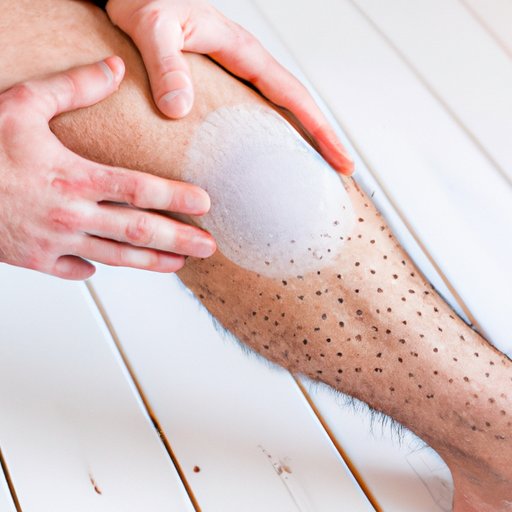
Introduction
Shingles is a painful condition caused by the varicella-zoster virus, the same virus responsible for causing chickenpox. While shingles most commonly occurs on the torso, it can also affect other parts of the body, including the leg. Understanding the symptoms, causes, and treatment options for shingles on the leg is important, as the condition can cause significant discomfort and even lead to complications. In this article, we will cover everything you need to know about shingles on the leg, including risk factors, prevention measures, and coping strategies.
Shingles on the Leg: Symptoms, Causes, and Treatment Options
Shingles on the leg causes a variety of symptoms, including pain and burning, rash, and blisters. It occurs when the varicella-zoster virus becomes reactivated in the nerve fibers that supply the skin on the leg.
Symptoms
- Pain and burning: Before the rash appears, many people experience pain, tingling, or burning in the affected area, which can be intense.
- Rash: A rash, typically starting as small red spots, rapidly develops into groups of painful, fluid-filled blisters. The rash is usually localized to one side of the leg.
- Blisters: These blisters can break open and crust over, causing scarring if not appropriately treated.
Causes
- Varicella-zoster virus: Shingles is caused by the same virus that causes chickenpox. After recovering from chickenpox, the virus can remain dormant in nerve tissue for years before reactivating as shingles.
- Age: The risk of developing shingles increases with age, as the immune system weakens over time.
- Weakened immune system: Certain medical conditions or medications can weaken the immune system, making it more susceptible to infections such as shingles.
Treatment options
- Antiviral medication: Antiviral drugs such as acyclovir, valacyclovir, or famciclovir can be effective at reducing the severity and duration of shingles on the leg. They work by inhibiting the replication of the virus.
- Pain relief medication: Pain is a significant symptom of shingles on the leg, and pain relief medication such as acetaminophen or ibuprofen can help to alleviate discomfort. Prescription medication may also be necessary for severe pain.
- Topical creams: Calamine lotion or other topical creams can help to soothe the rash and reduce itching. Topical anesthetics may also be prescribed to numb the area and reduce pain.
How to Recognize and Treat Shingles on Your Leg
If you suspect that you may have shingles on your leg, it’s essential to recognize the symptoms and seek medical attention promptly to minimize discomfort and prevent complications.
Recognizing Symptoms
Shingles on the leg typically presents as pain and burning in the affected area, followed by a rash of fluid-filled blisters. Symptoms may also include fatigue, fever, and headache.
Seeking Medical Attention
If you suspect that you may have shingles on your leg, it’s important to see a healthcare provider promptly. Treatment with antiviral medication is most effective when started within 72 hours of the onset of symptoms.
Treatment options
- Antiviral medication: As previously mentioned, antiviral drugs can significantly reduce the severity of shingles on the leg when taken early.
- Pain relief medication: Over-the-counter pain relief medication can help to alleviate discomfort, while prescription medications may be necessary for severe pain.
- Topical creams: Topical creams can help to soothe the rash and reduce itching.

Can You Get Shingles on Your Leg: Understanding the Risks
While shingles on the leg can affect anyone, certain risk factors increase the likelihood of developing the condition.
Risk Factors
- Age: The risk of developing shingles increases significantly after the age of 50, as the immune system weakens over time.
- Weak immune system: Medical conditions or medications that weaken the immune system increase the risk of developing shingles.
- Stress: Emotional or physical stress can weaken the immune system, making it more susceptible to viral infections such as shingles.
Prevention Measures
- Vaccination: The shingles vaccine is highly effective at reducing the risk of developing shingles. It is recommended that people over the age of 50 receive the vaccine, even if they have had shingles previously.
- Stress reduction: Engaging in stress reduction techniques such as mindfulness, meditation, or exercise can help to boost the immune system and reduce the risk of developing shingles.
- Boosting immune system: Eating a healthy diet, getting adequate rest, and avoiding smoking and alcohol can help to strengthen the immune system and reduce the risk of infection.
When Shingles Strikes the Leg: What You Should Know
While shingles on the leg can be uncomfortable, it can also lead to complications if left untreated.
Possible Complications
- Postherpetic neuralgia: This condition causes chronic pain in the affected area long after the rash has healed.
- Eye complications: If the shingles rash occurs near the eye, it can lead to eye infections and vision loss.
Importance of Early Treatment
Early treatment of shingles on the leg can significantly reduce the severity of symptoms and prevent complications.
Lifestyle Changes to Prevent Recurrence
While shingles on the leg can recur, certain lifestyle changes can help to reduce the risk of a subsequent episode. These include reducing stress, getting adequate rest, and boosting the immune system through healthy lifestyle choices.
Shingles on the Lower Limbs: Diagnosis and Management
If you suspect that you have shingles on your leg, a healthcare provider can make a diagnosis through visual examination and lab tests.
Diagnosis Methods
- Visual examination: A healthcare provider will examine the rash and blisters to make a diagnosis.
- Lab tests: Lab tests such as blood tests or viral cultures can confirm the diagnosis of shingles.
Management Techniques
The management of shingles on the leg involves the treatment of symptoms and steps to prevent the spread of the virus.
- Pain relief: Over-the-counter pain medication can help to alleviate discomfort, while prescription medication may be necessary for severe pain.
- Avoiding skin-to-skin contact: Shingles can be spread through direct contact with the rash or blisters. It’s essential to avoid skin-to-skin contact with other people until the rash has completely healed.
- Cleaning and covering blisters: Keeping the rash and blisters clean and covered can promote healing and prevent infection.
The Link Between Shingles and the Leg: Exploring the Science
Understanding the science behind shingles can help to explain why the condition affects specific areas of the body.
Understanding the varicella-zoster virus
- Transmission: The varicella-zoster virus is highly contagious and can be transmitted through respiratory secretions or direct contact with the rash or blisters.
- Dormancy: After a chickenpox infection, the virus becomes dormant in nerve tissue and can remain there for years until it becomes reactivated as shingles.
- Reactivation: It’s still not entirely clear why the virus becomes reactivated, but it’s believed to be related to a weakened immune system or aging.
Nerve Involvement in Shingles
Shingles on the leg occurs when the varicella-zoster virus becomes reactivated in the nerve fibers that supply the skin on the leg.
Role of Location in Shingles Symptoms
The location of the rash can affect the severity of symptoms. For example, shingles near the eye can cause vision loss, while shingles on the leg can be particularly painful and difficult to treat.
Living with Shingles on Your Leg: Coping Strategies and Support Resources
If you are living with shingles on your leg, there are several coping strategies and support resources available to help you manage the condition.
Coping Strategies
- Pain management techniques: Techniques such as deep breathing, meditation, or distraction can help to alleviate pain and discomfort.
- Relaxation techniques: Engaging in relaxation techniques such as yoga or meditation can help to reduce stress and promote healing.
- Care for blisters and rash: Keeping the rash and blisters clean and covered can promote healing and prevent infection.
Support Resources
- Support groups: Joining a support group for people with shingles can provide emotional support and practical advice for coping with the condition.
- Online communities: Online communities such as forums or social media groups can provide a supportive environment for people living with shingles.
- Healthcare providers: Your healthcare provider can provide guidance and support for managing shingles on the leg.
Conclusion
Shingles on the leg can cause considerable discomfort and lead to complications if left untreated. Understanding the symptoms, causes, and treatment options for shingles on the leg is essential, as is seeking medical attention promptly if you suspect that you may have the condition. With appropriate treatment and management strategies, it is possible to manage shingles and prevent complications.
If you are experiencing symptoms of shingles on the leg, don’t hesitate to make an appointment with your healthcare provider. With the right treatment and care, you can find relief and promote healing.





